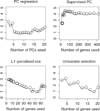Survival analysis with high-dimensional covariates
- PMID: 19654171
- PMCID: PMC4806549
- DOI: 10.1177/0962280209105024
Survival analysis with high-dimensional covariates
Erratum in
- Stat Methods Med Res. 2010 Apr;19(2):200
Abstract
In recent years, breakthroughs in biomedical technology have led to a wealth of data in which the number of features (for instance, genes on which expression measurements are available) exceeds the number of observations (e.g. patients). Sometimes survival outcomes are also available for those same observations. In this case, one might be interested in (a) identifying features that are associated with survival (in a univariate sense), and (b) developing a multivariate model for the relationship between the features and survival that can be used to predict survival in a new observation. Due to the high dimensionality of this data, most classical statistical methods for survival analysis cannot be applied directly. Here, we review a number of methods from the literature that address these two problems.
Figures




Similar articles
-
Univariate shrinkage in the cox model for high dimensional data.Stat Appl Genet Mol Biol. 2009;8(1):Article21. doi: 10.2202/1544-6115.1438. Epub 2009 Apr 14. Stat Appl Genet Mol Biol. 2009. PMID: 19409065 Free PMC article.
-
Covariate dimension reduction for survival data via the Gaussian process latent variable model.Stat Med. 2016 Apr 15;35(8):1340-53. doi: 10.1002/sim.6784. Epub 2015 Nov 3. Stat Med. 2016. PMID: 26526057
-
Boosting method for nonlinear transformation models with censored survival data.Biostatistics. 2008 Oct;9(4):658-67. doi: 10.1093/biostatistics/kxn005. Epub 2008 Mar 15. Biostatistics. 2008. PMID: 18344565
-
Survival analysis tools in genomics research.Hum Genomics. 2014 Nov 25;8(1):21. doi: 10.1186/s40246-014-0021-z. Hum Genomics. 2014. PMID: 25421963 Free PMC article. Review.
-
Partial least squares: a versatile tool for the analysis of high-dimensional genomic data.Brief Bioinform. 2007 Jan;8(1):32-44. doi: 10.1093/bib/bbl016. Epub 2006 May 26. Brief Bioinform. 2007. PMID: 16772269 Review.
Cited by
-
Identification of CT-based non-invasive radiomic biomarkers for overall survival prediction in oral cavity squamous cell carcinoma.Sci Rep. 2023 Dec 8;13(1):21774. doi: 10.1038/s41598-023-48048-x. Sci Rep. 2023. PMID: 38066047 Free PMC article.
-
Network-based survival analysis reveals subnetwork signatures for predicting outcomes of ovarian cancer treatment.PLoS Comput Biol. 2013;9(3):e1002975. doi: 10.1371/journal.pcbi.1002975. Epub 2013 Mar 21. PLoS Comput Biol. 2013. PMID: 23555212 Free PMC article.
-
Identifying gene-environment interactions incorporating prior information.Stat Med. 2019 Apr 30;38(9):1620-1633. doi: 10.1002/sim.8064. Epub 2019 Jan 13. Stat Med. 2019. PMID: 30637789 Free PMC article.
-
Histopathological Imaging⁻Environment Interactions in Cancer Modeling.Cancers (Basel). 2019 Apr 24;11(4):579. doi: 10.3390/cancers11040579. Cancers (Basel). 2019. PMID: 31022926 Free PMC article.
-
Identification of gene-environment interactions in cancer studies using penalization.Genomics. 2013 Oct;102(4):189-94. doi: 10.1016/j.ygeno.2013.08.006. Epub 2013 Aug 29. Genomics. 2013. PMID: 23994599 Free PMC article.
References
-
- Golub T, Slonim D, Tamayo P, et al. Molecular classification of cancer: class discovery and class prediction by gene expression monitoring. Science. 1999;286:531–536. - PubMed
-
- Hedenfalk I, Duggan D, Chen Y, Radmacher M, Bittner M, Simon R, et al. Gene-expression profiles in hereditary breast cancer. The New England Journal of Medicine. 2001;344:539–548. - PubMed
Publication types
MeSH terms
Grants and funding
LinkOut - more resources
Full Text Sources
Other Literature Sources

